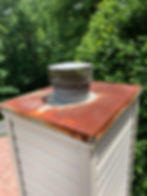Seasonal Chimney Maintenance
- smokerisechimney
- Aug 16, 2024
- 2 min read
Owning a wood burning appliance can be a great way to heat your home and enjoy the warmth of a good fire. When taken care of, your fireplace, wood stove or insert can last decades. There are some maintenance things to consider each year as you end the burning season and then get ready again as fall approaches. Here is a list of things to look for and do to ensure your appliance and chimney last for a long time.
Spring Maintenance
Heavy rains in the spring can show where water intrusion may be happening. Look at the exterior of your chimney and look for signs of discoloration, mold, or rust from your cap.
Do you have a cap? This prevents not just rain, but animals and leaves from coming in as well. Having a cap that covers the entire chimney keeps the crown (or flat part) of the chimney dry as well as the flue. Having a cap that has an overhang keeps water off the upper section of the chimney protecting the crown even further.
Look inside your firebox and chimney for any wetness or mildew smell. Overtime, bricks can absorb water and it can condensate and sit in your chimney.
If a brick chimney hasn’t been waterproofed in 10 years it may be time to have it done to prevent water intrusion.
check around the base of your chimney where it meets the roof line to check for any discoloration, dry rot or peeling.
Spring is a great time to have the chimney cleaned. Warm air can push down as pressure changes in the summer and bring in a smokey aroma. Having it cleaned in spring ensures the chimney is dry and ready for the next season.


Fall Maintenance
Do you have a cap with animal guards? Animal guards are a sort of metal hardware cloth that is built into the chimney cap. It wraps around all sides and prevents all sorts of animals from going into the flue and making a home and causing a dangerous obstruction.
Chimney Swifts are birds that are known in our area for using the protection of chimneys as a place to raise their young. Due to their population decline they are federally protected and can not be removed from the chimney while they are nesting. Closing your flue will prevent the birds from entering your home and they will leave in the fall once the babies learn how to fly.
We recommend having your chimney swept if there is a layer of soot 1/8th of an inch or greater. Setting an appointment for early in the fall is a much better time than in the middle of winter when we find ourselves busy with emergencies and last minute phone calls.
In our region you may not need to have your chimney swept every year but you should still have it inspected. Every chimney is different, so if you have any questions, call us.
Build a test fire, make sure to have a quick starting fire with paper to move out the old air and burn a small amount of wood to make sure everything is drafting as it should and all the bells and whistles on the wood stove are working as expected.





